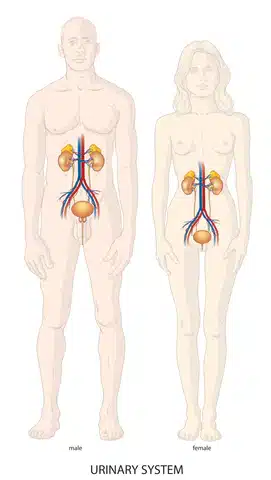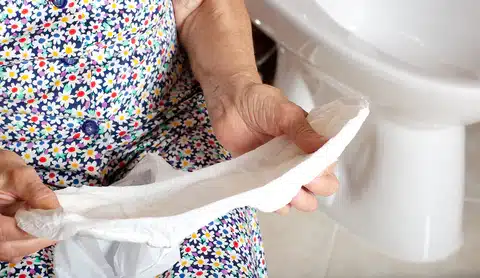Urinary problems are one of the most common problems we face. This is especially true as we age. And, like many things in life, incontinence affects men and women differently. As a result, working with the condition changes depending on the gender of the person. This is important, not only for carers to keep in mind but also those suffering from incontinence. Today we are discussing male vs female incontinence.

Anatomical Differences in Incontinence
The bladder is a stretchy, muscular sac that sits in the bottom of the pelvic. The bladder muscles are stimulated to relax or contract thanks to a complex system of nerves which are controlled unconsciously. While the urinary system functions in the same way for men and women, there are some physical differences.
For men, the urethra is about 18-20cms and runs through the prostate gland. This is why prostate issues can impact continence.
For women, the urethra is shorter – around 3-4cms. The pelvic floor muscles, which help with urine retention, can be weakened or damaged which can cause incontinence issues. This is why male and female incontinence products need to be as varied as the treatment options.
Further, the bottom of the bladder has a small sphincter that relaxes and opens as we will it to do so. However, for women, this muscle is not a complete circle. As a result, it is not as strong for women as it is for men. This is why pregnancy and damage to the pelvic floor can weaken the bladder, making women more prone to incontinence.

Male vs Female Incontinence Types
The prevalence of bladder issues, like frequent urination, or a strong and sudden urge to urinate, is similar for women and men, However, incontinence is almost three times more likely among women.
Women are more likely to experience stress incontinence. Further, women with a BMI over 30 are 22 times more likely to have urge incontinence than women with a BMI under 24.
Men, however, are more likely to have urge incontinence or “mixed” incontinence. Further, men with a history of prostate problems have a higher incidence of frequency and urge, but without urinary incontinence.
Finally, the symptoms of incontinence increase with age at about the same rate for both women and men. As a result, you need to take age and incontinence types into consideration when choosing male and female incontinence products.

When to Seek Medical Help for Incontinence
If you have symptoms of incontinence, you should discuss the issue with your doctor. In the case of men, incontinence can be linked to an underlying prostate issue. S a result, these symptoms should not be ignored or set aside as “part of getting older”.
For women, incontinence can be linked to a weak pelvic floor, prolapse or other physical conditions. As a result, you need to have a doctor investigate the issue. Never ignore incontinence as it could be a symptom of a bigger issue. You might also find you can treat, cure or manage your condition.
In many cases, the good news is that there are a number of effective solutions for bladder problems. There are medications for overactive bladders and even bladder stimulants. Further, there are medical procedures to help with anatomical issues.
And, if you need help managing your incontinence, there are amazing options available.

Managing Incontinence – Male vs Female Incontinence
If necessary, your doctor may recommend you use incontinence products to help manage your condition. These products are designed to absorb and contain the fast flow of a weak bladder. Incontinence products assist, not only in managing your condition, but keeping your dry and comfortable.
The choice of products is not only based on your type of incontinence but also the heaviness of the flow and your gender. While there are plenty of products that are unisex and easy to use, there are also specialist products for men and women.
For example, Holistic Incontinence carries a range of male guards that are designed for male anatomy. Further, the shape of incontinence underwear is different for male vs female incontinence.

How to Keep Your Bladder Healthy
Want to try and lessen your risk of incontinence? We have some tips below to keep your bladder healthy.
1: Do Not Smoke!
While we are bombarded with the connection between smoking and lung cancer, few people realise it affects your bladder. In fact, smoking increases your risk of bladder cancer.
2: Limit or Avoid Caffeine
Caffeine is a known diuretic. That means it not only makes you thirstier, faster, it also increases the frequency of urination. This will also occur with alcohol. Further, too much fluid intake can make an overactive bladder, worse.
3: Tips for Men
For men, especially those with enlarge prostates, it is recommended that you stop taking in fluids a few hours before bed. This reduces the need to get up frequently in the night.
4: Tips for Women
For women, it is important to practice your Kegel exercises to strengthen the pelvic floor and even the bladder sphincter. This is especially important if you have been pregnant or plan to be pregnant.
Do you need help managing your incontinence? Holistic incontinence has a wide range of male and female incontinence products online. Enjoy the discretion of online buying and shipping.
